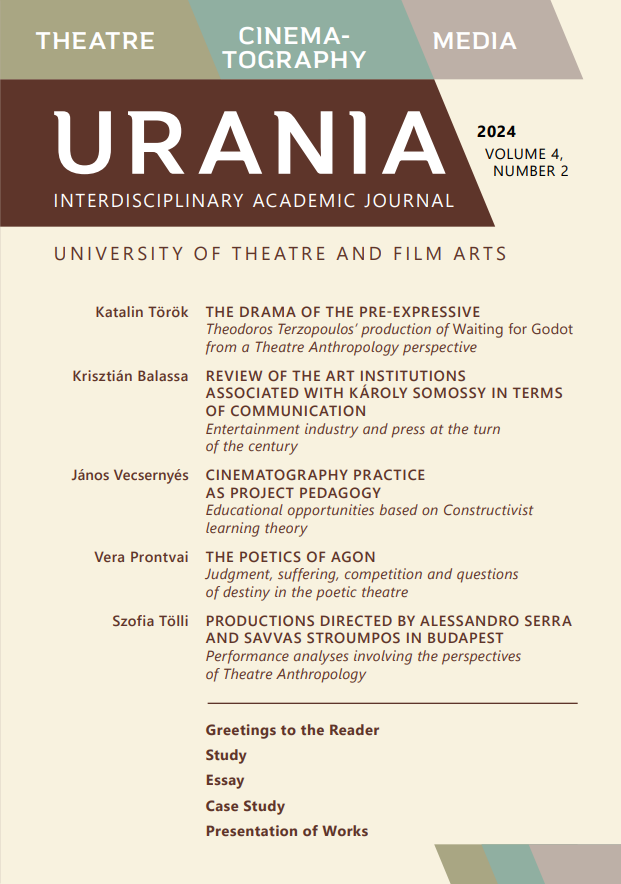The poetics of agon
Abstract
The case study explores the poetics of judgment, suffering, competition and the reversibility (or irreversibility) of fate in poetic theatre through Attila Vidnyánszky’s production of Agón. The director places brutality, death and confrontation with the sins of humanity at the centre of the performance, using the means of Artaud’s theatre of cruelty, based on the music and text by Péter Pál Józsa. Through the use of a language that he calls poetic theatre, Vidnyánszky depicts the historical and moral struggles of humanity: the collective sins of mankind, events of war and history, from antiquity to nuclear catastrophe. The Gesamtkunst staging is inspired by the spirit of Lucifer’s rebellion, the desire to destroy man, to eradicate himself, integrating both the martyrdom of the Forty Martyrs of Sebeste and the burial of Christ, which is typical of contemporary thinking. The performance can also be interpreted as a Madách paraphrase, because at the end, next to the man and woman entering the stage, there is a child who (perhaps) can bring about the reversal of humanity’s fate, and who (perhaps) will be able to build a cathedral from swear-words.
References
Artaud, Antonin. 1999. “Rendezés és metafizika.” In A színház és az istenek: Válogatott írások, translated by János Betlen. Budapest: Orpheusz.
Asman, Carrie L. 1992. “Theater and Agon / Agon and theater: Walter Benjamin and Florens Christian Rang.” MLN 1992 April, Vol. 107, No. 3: 606–624. German Issue, The Johns Hopkins University Press. https://doi.org/10.2307/2904948
Benjamin, Walter. 1980. Angelus Novus, Hungarian translation by György Bence, Ferenc Kőszeg, Péter Pó, László Rajnai and Dezső Tandori. Budapest: Magyar Helikon.
Hamvas, Béla. 1993. “Az agón.” In A babérligetkönyv / Hexakümion. Szombathely: Életünk Szerkesztősége – Magyar Írók Szövetsége.
Hegyi, Dániel Tibor. 2023. “A Nibelung-lakópark mint összművészeti alkotás.” In “A szellős térben és a szűk időben”: Tanulmányok Térey Jánosról, edited by Ágnes Balajthy, Gergő Melhardt and Dániel Szabolcs Radnai. Budapest: Petőfi Irodalmi Múzeum.
Lehmann, Hans-Thies. 2009. Posztdramatikus színház, Hungarian translation by Beatrix Kricsfalusi, Budapest: Balassi.
Madách, Imre. 2023. Az ember tragédiája. Budapest: Magvető.
Nietzsche, Friedrich. 1926. Vidám tudomány, Hungarian translation by Ödön Wildner. Budapest: Világirodalom Könyvkiadó Vállalat. Online access: https://mek.oszk.hu/15200/15256/15256.pdf (last visited: October 3, 2024).
Platón. N.d. Szókratész védőbeszéde, Hungarian translation by Gábor Devecseri. Online access: http://mek.niif.hu/00400/00460/00460.htm (last visited: March 1, 2024).
Verebes, Ernő. 2015. “Don Quijote.” In A titkok kapuja, edited by Vera Prontvai. Budapest: Mária Rádió. Online access: https://www.mariaradio.hu/musor/554/A_titkok_kapuja (last visited: March 28, 2023).
Visky, András. 2020. Mire való a színház? Útban a theatrum theologicum felé. Budapest: KRE–L’Harmattan.




